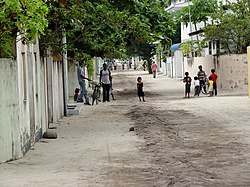Mahibadhoo
Mahibadhoo | |
|---|---|
 | |
| Coordinates: 3°45′27.07″N 72°58′7″E / 3.7575194°N 72.96861°E | |
| Country | Maldives |
| Administrative atoll | South Ari Atoll |
| Distance to Malé | 75.72 km (47.05 mi) |
| Government | |
| • President of the Mahibadhoo Council | Ahmed Khaleel |
| Area | |
| • Total | 0.1770 km2 (0.0683 sq mi) |
| Dimensions | |
| • Length | 1.00 km (0.62 mi) |
| • Width | 0.305 km (0.190 mi) |
| Population (2019)[1] | |
| • Total | 3,000 (including foreigners) |
| Time zone | UTC+05:00 (MST) |
| Website | www.facebook.com/visitmahibadhoo |
Mahibadhoo is a small island town in central Maldives, and is the administrative capital of South Ari Atoll.
Geography
The island is 75.72 km (47 mi; 41 nmi) southwest of the country's capital, Malé.[2] The island measures 2.4 km (1.5 mi) in length and 1.21 km (0.75 mi) in width.
Demography
| Year | Pop. | ±% |
|---|---|---|
| 2006 | 1,780 | — |
| 2014 | 1,939 | +8.9% |
| 2006-2014: Census populations Source: [3] | ||
Governance
Mahibadhoo island is governed by the Secretariat of Mahibadhoo Council. The island council is administered by the local government authority. The incumbent President of Mahibadhoo council is Ahmed Khaleel. The incumbent vice president is Gasim Shihan.
The Mahibadhoo Constituency, which includes neighboring Kun'burudhoo and Hangnaameedhoo, is represented in the parliament by Ahmed Thoriq, a parliamentary member of the Progressive Party of Maldives (PPM). In April 2019, Thoriq was elected for a second term, and will represent the constituency at least until 2024.
Economy
With a population of around 2500 people, the livelihood of most families depend on fishing (notably yellow fin tuna) and tourism. And as the administrative capital of South Ari atoll, a significant fraction of the workforce are employed in public service. Mahibadhoo has also seen a surge in local tourism and the guesthouse business, in addition to the growing number of small businesses ranging from coffee shops to grocery stores.
On January 12, 2020, a state-sponsored grouper farming project was launched in Mahibadhoo, led by the Ministry of Fisheries, Marine Resources and Agriculture. The pilot project is part of the sustainable fisheries resource development project of the ministry, and is being funded by the World Bank.
Infrastructure and Services
Notable public buildings in the island include the atoll council, atoll hospital, the island council, police station, atoll education center, a branch of BML, a magistrate court, a division of STELCO and of FENAKA corporation, an ice plant station, and four mosques (one of them no longer being used for worship).
The streets of Mahibadhoo, with the exception of some roads, are paved with stone.[4] Other public places include a FIFA-approved turf football ground, south harbor and its adjoining park, the north harbor, a netball ground and a mat-floored futsal pitch. On the western coast of the island resides "Bun'baru Beach" for the public, and a private beach exclusively for tourists.
Private facilities in Mahibadhoo include eight guesthouses, two speedboat ferry service providers, and around a dozen coffee shops/restaurants/delis.
Education
In Mahibadhoo, education for adolescents begin from baby-nursery at the Mahibadhoo Pre-school. Primary and secondary schooling, up to O'levels (Grade 10) is provided by the Atoll Education Center. Students can choose between business and science streams to major in. Students in pursuit of high school education continue their studies in capital Male'.
Mahibadhoo exhibits a campus of Villa College, which offers courses from certificate level to bachelor's and master's degrees.
Healthcare
Services provided by the Atoll Hospital include blood transfusion, E.C.G, laboratory investigations, gynecology related operations, x-ray, ultra sound scanning and family planning. Specialist consultations include gynecology pediatrics and an annual circumcision camp.
In addition, Procare Clinic and Dental Centre operates as a private clinic, and provides occasional specialist consultations, in addition to basic healthcare facilities.
Sports and Recreation
Mahibadhoo is known nationwide for its endeavors in sports, remarkably for the development of football players. Mahibadhoo is the homeland of former national team goalkeeper, Imran Mohamed, and former national team striker, Ahmed Thoriq. The two of them have retired from professional football. Other notable football players from Mahibadhoo include Samooh Ali, Asadhulla Abdhulla, Hussain Niyaz Mohamed,
In 2010, Imran and Tariq founded Mahibadhoo Sports Club. It functions as an association that organizes and leads sporting events within the island, as well as a club that participates in national football leagues. The club holds a one-day futsal tournament every year. The Mahibadhoo Sports Club Academy trains kids to become future football stars and to lead a healthy childhood.
The secretariat of Mahibadhoo holds annual football, netball and handball tournaments. In addition, a fitness club named "Kamana" leads a fitness program exclusively for women, to promote women's health and wellbeing.
References
- ^ "Table PP5: Resident Population by sex, nationality and locality (administrative islands), 2014" (PDF). Population and Households Census 2014. National Bureau of Statistics. p. 35. Retrieved 12 August 2018.
- ^ "Coordinate Distance Calculator". Boulter.com. Retrieved 12 August 2018.
- ^ "Table 3.3: Total Maldivian Population by Islands" (PDF). National Bureau of Statistics. Retrieved 12 August 2018.
- ^ "Press release on the completion of Mahibadhoo road development project". Press release, the President's Office. 3 September 2018. Retrieved 25 February 2020.

